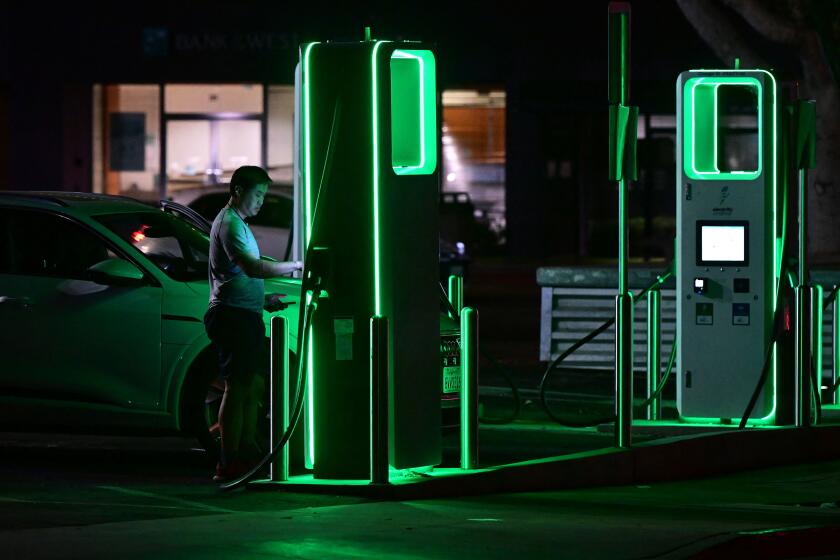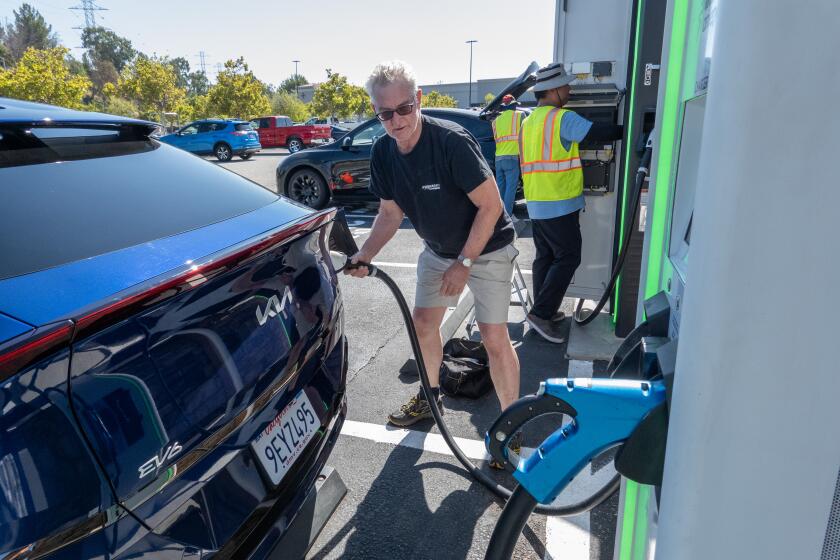Tony Briscoe is an environmental reporter with the Los Angeles Times. His coverage focuses on the intersection of air quality and environmental health. Prior to joining The Times, Briscoe was an investigative reporter for ProPublica in Chicago and an environmental beat reporter at the Chicago Tribune.
1
A network of air monitors installed in Northern California has provided scientists with some of the first measurable evidence quantifying how much electric vehicles are shrinking the carbon footprint of a large urban area.
Researchers from UC Berkeley set up dozens of sensors across the Bay Area to monitor planet-warming carbon dioxide, the super-abundant greenhouse gas produced when fossil fuels are burned.
Aggressive and impactful reporting on climate change, the environment, health and science.
Between 2018 and 2022, the region’s carbon emissions fell by 1.8% each year, which the Berkeley researchers concluded was almost exclusively owed to drivers switching to electric vehicles, according to a study published Thursday in the journal Environmental Science & Technology.
In that time, Californians purchased about 719,500 zero-emission or plug-in hybrid vehicles, more than triple the amount compared to the previous five years, according to the California Department of Energy. The Bay Area also had a higher rate of electric vehicle adoption than the state as a whole.
While the findings confirm the state’s transition to zero-emission vehicles is substantially lowering carbon emissions, it also reveals these reductions are still not on pace to meet the state’s ambitious climate goals.
Emissions need to be cut by around 3.7% annually, or nearly twice the rate observed by the monitors, according to Ronald Cohen, UC Berkeley professor of chemistry. Although cars and trucks are the state’s largest source of carbon emissions, it underscores the need to deploy zero-emission technology inside homes and for the power grid.
California electric vehicle sales dropped significantly in the last half of 2023, raising questions about the state’s ability to phase out gas-powered cars.
“I think what we see right now is evidence of strong success in the transportation sector,” Cohen said. “We’re going to need equally strong success in home and commercial heating, and in the [industrial] sources. We don’t yet see significant movement in those, but policy pushing on those is not as far ahead as policy on electric vehicles.”
Although cities only cover roughly 3% of global surface area, they produce about 70% of carbon emissions. Urban monitoring networks could give policymakers a more granular view of the sources of pollution.
Los Angeles and other major cities have set up Cohen’s monitors in hopes it could reveal more insights about carbon emissions and air pollution.
As government agencies continue to assess efforts to decarbonize the economy through socioeconomic data and computer models, experts argue that monitoring networks like Berkeley’s could provide a sorely needed reality check for some communities and offer another tool to verify the effectiveness of climate policies.
“I think the best contribution this makes is showing how we can check what’s going on,” said Danny Cullenward, a climate economist and senior fellow at the Kleinman Center for Energy Policy at the University of Pennsylvania. “It’s probably not the last word. But it’s an elegant way to ground-truth some of these things. We need more of these approaches, not fewer.”
These systems could also reveal blind spots. California, for example, doesn’t account for greenhouse gases leaking out of unplugged oil wells or carbon emissions from biofuels, such as power plants that burn woody waste.
“The atmosphere doesn’t care,” Cullenward said. “You can still measure it.”
California has ambitious climate goals, including a pledge to ban the sale of new gasoline- and diesel-powered cars and light trucks by 2035.
The largest deterrent to installing such networks is funding. But the equipment has become more inexpensive over the years: Each of the Berkeley sensors costs less than $10,000.
But the intention, Cohen said, is not to replace the current modes of climate accounting. He hopes those methods and his will work together.
“We’re not suggesting that you do one in the absence of the other, but that they are stronger together.”
Toward a more sustainable California
Get Boiling Point, our newsletter exploring climate change, energy and the environment, and become part of the conversation — and the solution.
You may occasionally receive promotional content from the Los Angeles Times.








